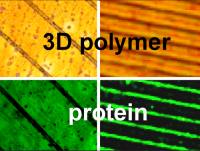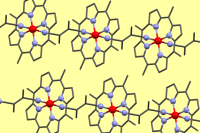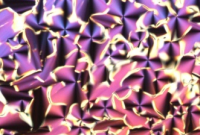 Research in the Department
Research in the Department
Experimental groups that form the Department work in molecular engineering, i.e. organisation of molecules with optimal molecular architecture into larger ensembles (from molecular aggregates to condensed matter phases) that promote collective properties interesting for advanced nano- and bio-technological applications.
Molecular nanofilms 
We study surface and interfacial phenomena in macromolecular systems - synthetic polymers and biomolecules. An example would be self-organisation of blends of molecules with different functionalities that allows for one-step solution deposition of films with ordered domains. Such domains could form complementary elements of organic solar cells, "plastic" chips, plates for protein microarrays. The self-organisation processes are controlled using Self-Assembled Monolayers and soft lithography. Within two large EU projects we analyse multimolecular films that recognize proteins or DNA, and are applied in biosensors. Moreover, we observe interesting biomedical properties of coatings and micropatterns made of "intelligent" (i.e. environmental stimuli-sensitive) or peptide-mimetic polymers that enforce specific behaviour of proteins and cells. More information...
Magnetism of materials 
Our research topics also include experimental investigations of magnetic properties of molecular crystals. Such materials are amazing due to the diversity of their magnetic behaviours. We observe photomagnetism (switching of the magnetic properties by light), magnetic sponge behaviour (the influence of solvent molecules on magnetic properties), and we search for magnetic relaxations and quantum tunnelling in low-dimensional systems. Another topic concerns electronic properties of complex ruthenium oxides. Our measurements are performed down to very low temperatures achieved using liquid helium and helium-3. This is possible owing to the helium liquefaction station. More details...
Liquid crystals 
The subject of the research are mainly chiral and achiral liquid crystals exhibiting rich phase polymorphism, their mixtures and nanocomposites based on a liquid crystal matrix with ferro and/or antiferroelectric phase, doped with nanoparticles (BaTiO3, Fe2O3, Au), in terms of their applications in optoelectronic devices. We also study functional, environmentally friendly materials: biodegradable polymers such as L, D-PLA, Ecoflex® or polycaprolactone (PCL) doped with both nanocompounds such as narrow-walled carbon nanotubes (SWCN) and liquid crystal like 5CB (4-cyano-4'-pentylbiphenyl), in terms of their potential use as a modified flexible electrode in optoelectronic devices such as luminescent diodes or solar cells. Additionally, we analyze the behavior of DNA-surfactant complexes at the liquid-gas interface, as well as their behavior after transfer to a solid substrate (mica and silicon). Read more...